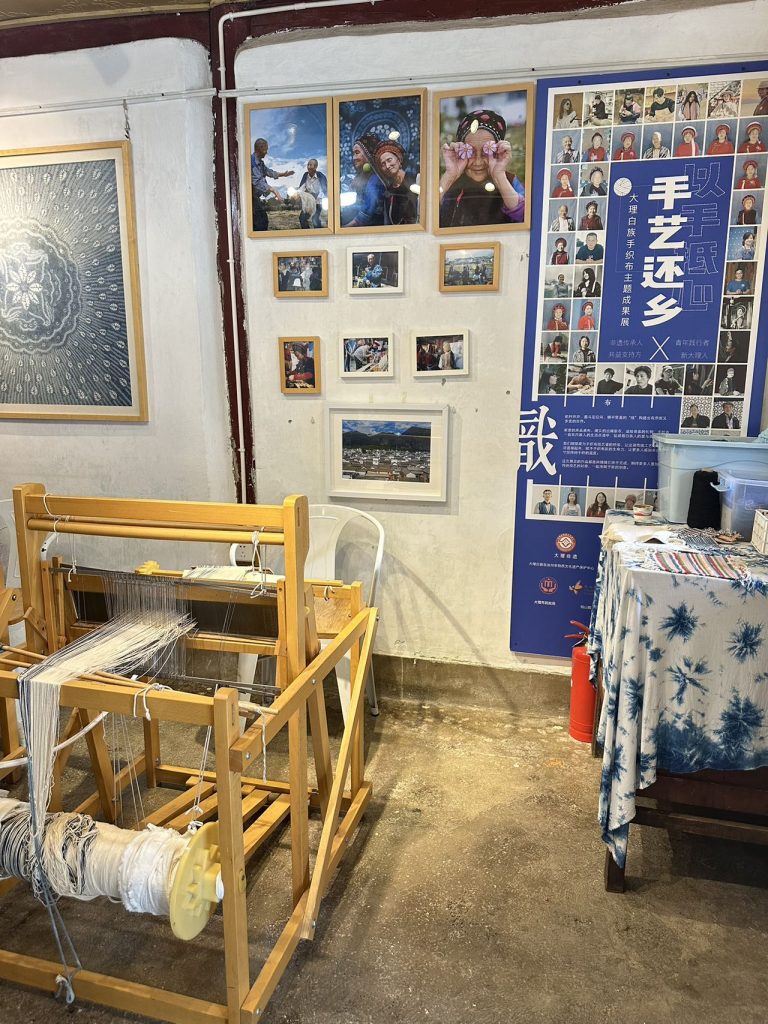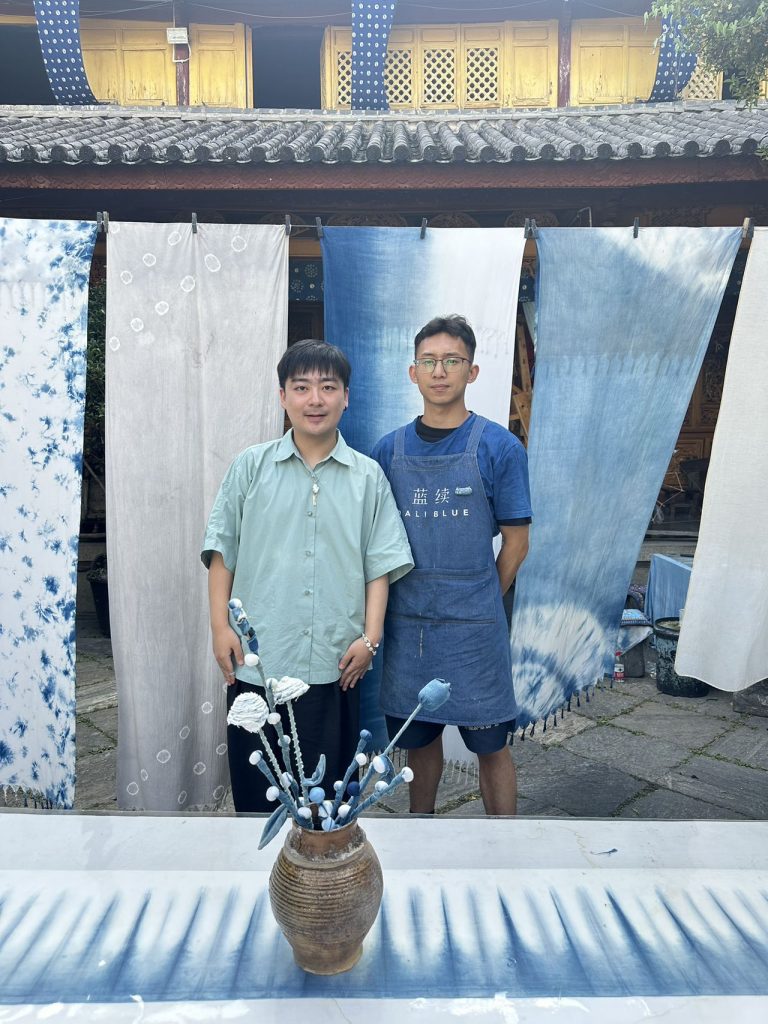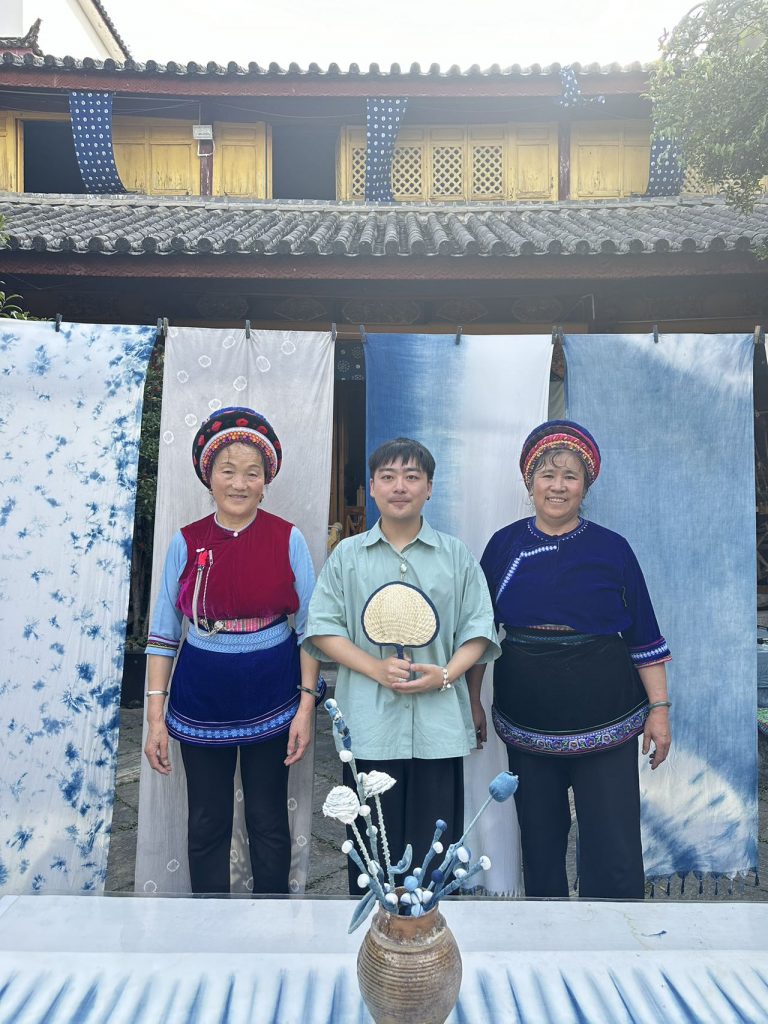

After the tie-dyeing course, I interviewed two staff members, who are also inheritors of the intangible cultural heritage. When they gave me their answers, I could see that they were very passionate about their work. After the interview, the male staff member told me that he hoped that one day the Bai ethnic group’s tie-dyeing could go global, so that more people could see and understand the Bai ethnic group’s story.



- What role do you think tie dye plays in Bai ethnic culture?
In Bai ethnic culture, tie dyeing plays a role as just a part of the Bai ethnic culture. It is like one of the most splendid inheritances among the Bai people.
- Can you briefly introduce the materials and tools used in the tie-dyeing process?
In tie dyeing, the main tool used is the line. In the older generation, tie dyeing is referred to as “jiao” in the local dialect, which means twisting the fabric together with threads and needles. We also use tools like printing boards for the base pattern and various dyeing tools.
- Can dyeing materials be purchased in our daily life?
Dyeing tools can be purchased everywhere. For example, we have our own plantation of natural materials like indigo. Although we have our own plantations, we still cannot meet the demand. So, we also buy materials from places like Honghe City in Yunnan and Guiyang City in Guizhou where indigo is more abundant.
- What are some of the most traditional patterns and textures in tie dyeing?
The most traditional patterns involve recombining basic patterns. Different techniques can create different patterns. One of the most distinctive symbols is the butterfly. In Bai culture, butterflies symbolize yearning for love and hopes for good luck and prosperity.
- Do you think the younger generation of the Bai people have a certain understanding of tie-dyeing techniques?
Most households are familiar with tie dyeing and some young people in their teens and twenties engage in tie dyeing making as well.
- In your observation, do many foreign tourists come to Dali specifically for Bai tie dyeing?
I know many foreigners who are very interested in tie dyeing. For instance, there are study groups that bring foreign friends for research. We show them around our plantations, explain the processes, and allow them to experience tie dyeing making. They really appreciate and enjoy this traditional cultural experience.
- What are the differences between Bai tie dyeing and common tie-dyeing practices?
Bai tie dyeing is a traditional intangible cultural heritage in China. The differences in the materials used, the dyeing techniques, and some unique traditional animal motifs exclusive to the Bai people, such as caterpillars, small butterflies, and horse teeth patterns.
- Do you think Bai tie dyeing will become less traditional over time, given that many people now use industrial dyes for coloring?
Our most traditional method involves using natural plant dyes for Bai tie dyeing. However, plant-based dyeing will continue to be passed down as it is an integral part of our heritage. Some in the village may adopt chemical dyeing methods, but the traditional method involves the natural oxidation of plant nutrients.
- When you see someone wearing traditional Bai batik clothing, do you feel a sense of pride?
If I see someone like a foreign friend wearing Bai tie dyeing clothing, I feel proud. For locals, it’s a common sight, but for visitors or people from big cities who appreciate the cultural attire, it evokes a sense of pride.
- How do you think tie dyeing techniques should be better inherited and promoted?
For inheritance and promotion, it would be helpful if friends or tourists who visit and experience batik share their positive experiences on social media to help spread awareness. Passing down the craft involves teaching it from one generation to the next so that more people can learn and carry on this cultural tradition.
———————————————————————————

Because the Bai grandmother only speaks the Bai language and is not very proficient in Chinese, it was a little difficult to interview her. The following is a summary of what the Bai grandmother said.
“When I was a child (my parents’ generation), there weren’t that many patterns in Dali Bai tie-dye. There were only butterflies, caterpillars, bees and various common flowers. About 30-40 years ago, there weren’t that many workshops that could offer tourists experiences, and everyone did tie-dyeing in a large factory. In fact, tie-dyeing has become simpler now, and the patterns are becoming more and more diverse. But many patterns are derived because children like them, and these patterns are no longer very similar to Bai culture.”
———————————————————————————
Then I asked the Bai grandmother in detail about the story of bees, butterflies and Bai people.
About the story of bees and Dali Bai people:
Dali Bai Autonomous Prefecture suffered a serious disaster at that time, and the village fell into famine and distress. But at that time, a group of bees appeared and brought honey and pollen, which made the crops grow again and made the whole village full of vitality again. Therefore, bees are regarded as a sacred existence, representing the value of labor and the spirit of dedication, teaching people to cherish nature and learn to be grateful.
The story about butterflies and the Bai people in Dali:
There is a legend in Dali that a pair of Bai lovers (Xia Lang and Wen Gu) committed suicide by jumping into a spring to resist feudal marriage. However, people did not see the bodies next to the spring the next day, but saw many butterflies emerging from the spring. Later, this place was named Picture of Butterfly Spring Park. On the 15th day of the fourth lunar month of the Chinese calendar, young Bai men and women dressed in their national costumes and came to the Picture of Butterfly Spring Park, which symbolizes love, to commemorate them. Therefore, in the Bai people of Dali, butterflies symbolize sacred love.